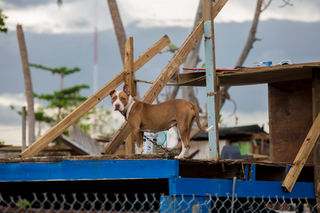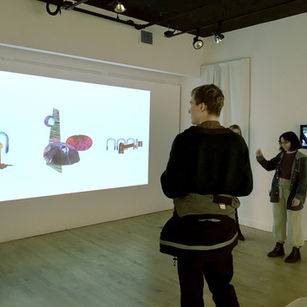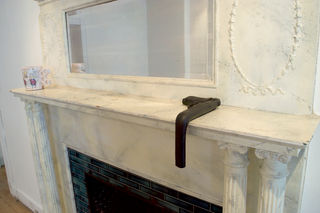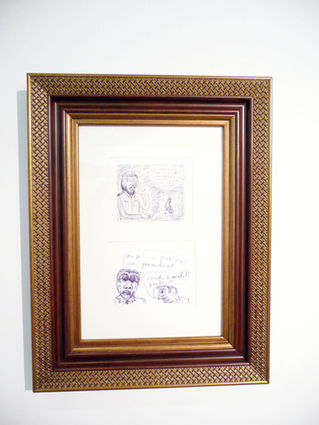Villa Victoria Center for the Arts 2017-2018
I created and implemented a visual arts program, resulting in eight multimedia visual arts exhibitions by Latin American and Latinx Artists, working closely with established and emerging visual artists, curators, grantees, performers and high profile local art organizations. I also assisted with programming and daily operations of the lively Performing Arts Program which features music, theater and dance.
The Power that Voice Has: A story of Latino Space in the South End of Boston July 2018
We are pleased to partner with the Harvard Graduate School of Design to commemorate the legacy of lBA as a paradigmatic example of Boricua activism and its success in defining its own Latino Space in Boston. In light of IBA’s 50th anniversary, this exhibit seeks to document this organizations’ development since its foundation in 1967; juxtaposing past and present and observing the spatial and social interplays with its immediate surroundings, in hopes of evoking newer subjectivities that can result in renewed perspectives for the future.

Estelas de Maria: Puerto Rico after the Storm June 2018
In September 2017, Puerto Rico was devastated by two hurricanes just two weeks apart: first Irma, then María. The cleanup began immediately, and soon individuals and organizations across the mainland United States were rallying to send aid to the island.
WBUR reporter Simón Rios began reporting on these efforts in Massachusetts, and he and photographer Jesse Costa decided to travel to the island to look at how local fundraising efforts were affecting people in Puerto Rico. Their work details not only the destruction of Puerto Rico, but also the reconstruction that began in the immediate wake of Hurricane Maria. That reconstruction is expected to continue for years to come.
Joining WBUR is Boston Globe photographer Jessica Rinaldi. Rinaldi traveled to Puerto Rico on a reporting trip in the days after the storm.
ABOUT THE TEAM:
Jesse Costa has been the multimedia producer for WBUR since 2007. He is a visual storyteller focusing on a wide array of topics and issues concerning healthcare, immigration, the environment, the arts and education. Among the many news outlets where his work has been featured include; The Associated Press, The Boston Globe and The Photo District News. His work has won numerous awards, most recently an Edward R. Murrow award for "Excellence in Video" for Reasonable Doubts: Reopening The Darrell 'Diamond' Jones Case - The Trial in 2017.
Simón Rios is a bilingual radio reporter at WBUR, Boston’s NPR News station. He worked as a musician, carpenter’s helper, cab driver and freelance reporter before taking a reporter position at the New Bedford Standard-Times in 2013, and joining WBUR in 2015. Rios has won multiple awards for his print and radio reporting, he plays classical guitar, and speaks Spanish in addition to working Portuguese. He is a native of Boston and a proud Uruguayan-American.
Jessica Rinaldi is a staff photographer for The Boston Globe. In 2016 she was awarded the Pulitzer Prize in Feature Photography for The Life and Times of Strider Wolf and was also named a Pulitzer Finalist in the same category. Prior to joining The Boston Globe she spent ten years as a contract photographer for Reuters based in Boston, Dallas and New York City. She has a B.S. in Journalism from Boston University.

Emergente April - May2018
This exhibition is a partnership between Villa Victoria Center for the Arts and A R E A Gallery, showcasing works by emerging artists of Latin American origin or heritage. The show draws a small sample of the diverse Latin identities present across the vast territories of the Americas. Culture is a construct, composed of myriad life experiences, some which can be chosen or controlled, others unpredictable and negotiated as they present themselves.
Emergente does not propose a grouping by similarities, it recognizes a connective thread throughout Latin American cultures, however delicate or elusive - through shared experiences of cultural tradition, ethnic diversity, colonialism, authoritarianism, resistance, navigating ever expanding mega-cities, overcoming inequality, poverty, dislocation and misrepresentation. It acknowledges and welcomes the broad umbrella of Latinidad, especially when considering the cultural cross-pollination from the migration patterns between the Americas. Featuring the work of emerging contemporary artists based or working in New England, the exhibition reaffirms La Galería at Villa Victoria Center for the Arts as a space for fostering experimentation, representation and building a community for the Latin population in Boston.


La Tierra del Olvido

Marca X January-February 2018
A partnership between Villa Victoria Center for the Arts, the Boston LGBTQIA Artists Alliance (BLAA), the Harvard Ed Portal Crossings Gallery (HEP), and the David Rockefeller Center for Latin American Studies (DRCLAS), this exhibition celebrates BLAA’s fourteenth exhibition. La Galería is proud to serve as a platform for the self-expression of LGBTQIA Latinx artists, a segment often marginalized even within their own communities by more ubiquitous cultures. VVCA welcomes BLAA, an artist collective based in Boston, organized around the desire to build safe spaces, and offer representation for LGBTQIA artists. This show celebrates the power of artist run organizations, as well as intersectional identities. Marca X provides a space for empowering the Latinx LGBTQIA community, increasing their representation and visibility in the culture at large, bringing together several unique, distinctive voices, both conceptually and aesthetically, into a larger collective conversation about contemporary intersectionality.
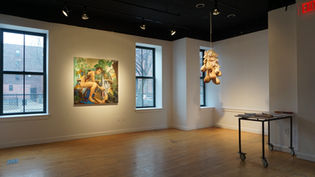
A Father's Lullaby and IN-sight Boston
The result of a community collaboration, this participatory exhibition brings together multitude of voices, personal accounts, sounds, and visual arts. Projects led by Boston Artist-in-Residence, Rashin Fahandej, generate social engagement and initiate dialogues to bring to focus the issues of “access” and “equality” informed by the critique of incarceration policies and its racial disparities. Projects utilized various media and celebrate the voices of collective as agents for change and creating new social memories.
A Father’s Lullaby highlights the role of men in raising children while underlines the absence of fathers due to racial disparities of mass incarceration. Policies have taken their tolls on young children, our next generations. This contributory project invites the community to record their voices, share their insights, and sing a lullaby to raise voice for this issue and to collectively imagine social policies based on support not criminalization.

Cubaneo Mark Guglielmo October 2017
Guglielmo visited Cuba 3 times in one year to document the impact of such events as President Obama’s landmark trip and the country after the death of Fidel Castro. Returning to the states with thousands of photographs and dozens of interviews from locals, Guglielmo constructed large mosaics with his own two hands and combined the perspectives and voices into this visual and auditory exhibition. This work pays homage to the rich culture of this isolated island and serves as a conversation piece for this historic turning point.
This exhibition is open from October 6, 2017 - October 27, 2017. It is curated by David Guerra, Director of A R E A gallery.






Mis Raises Pedro Cruz September 2017
As a teenager, living the “typical life of a city kid,” Cruz merely thought of PR as a vacation destination or a place his parents could refer to when reminding him of “how good [he] had it.” But, as he grew older, Cruz realized the influence that his culture had on his artistic work. With a passion for documentary photography, Cruz returned to his roots, to “stop time & save memories” in the best way he knew how. Tracing the footsteps of his parents, Cruz went on a journey that would reconnect him with his family, his culture, and his homeland.
Come and explore the streets of Puerto Rico through Cruz’s eyes, it will evoke feelings of nostalgia and maybe even inspire you to discover your own roots.There will also be live music from "Son De Altura," a two-man band consisting of Puerto Rican flutist, Tito Lugo, and Jose Aponte, a longtime Villa Victoria resident.

Nave Gallery Annex March 2016
This show is a fleeting exploration of the home as concept and lived material space in which taste, anxiety, and desire take shape. Playfully using the concepts of the uncanny and the “uncanny valley” as points of reference, selected objects and their placement within a house-turned gallery are meant to call attention to the act of attaching emotions to objects in domestic space and the ways that these are formed by the transformations of ourselves and occupied spaces. The home takes on a special role as site of origin and desired return – an (extra)ordinary domestic environment filled with art that may provoke empathy or aversion.
Each artwork experiments with common items such as silverware, clothing, and drinking vessels that simultaneously maintain their likeness to everyday things, while also marking a deviation from their original role or look. Each object plays with the frustrations that accompany our desires, our conflicting sensations of attainment and loss, of agency and impotence, of safety and fear through the representations of objects caught in the act of divergence.

The π group was envisioned in the beginning of 2005 by Julia Csekö, Daniel Murgel and Pedro Varela, during their BFA program at the Fine Arts University of Rio de Janeiro, UFRJ EBA. During a conversation between these young artists, the idea of an art collective which would function by maintaining core founding members, while remaining open to temporary collaborations was born. The idea caught on and the group went on organize 5 independent art exhibitions between 2005 and 2008. The group is named as a tribute to Brazilian artist and performer Márcia X, who passed away in the early 2000's. the group was inspired by the desire to provide continuity to Marcia's vision and actively participate as a cultural agitator in Rio de Janeiro, Brazil. Py was the name of the street where the first exhibition organized by GroupPy took place. This was the same strategy used by Marcia X, who organized and curated art exhibitions in unconventional venues, tilted Orlândia, which started off at a vacant house at Jornalista Orlando Dantas St. in Rio de Janeiro. Group Py’s first exhibition was titled π ≅ X Open Circuit. Four houses under construction on Py St. were occupied by 28 artists on February 2005. The group remained active until 2008, changing in size and configuration, gravitating around what came to be its core founding members Julia Csekö and Joana Traub Csekö. The group and it's events were received with great support by the local community including Brazilian sculptor Ernest Neto, who participated in some exhibitions and served as a mentor and friend to the collective.
FebeaRIO 2008
Febeario or 'By the fruits you shall know the tree'
The dictatorship is gone, but the Febeapá* remaines. If the early years of the military coup yielded material for volumes of the "Festival-de-Besteiras-que-Assola-o-país” “the-festival-of-nonsense-which-plagues-the-country ", our two decades of "democracy" have been equally lavish in barbarities perpetrated in the exercise of public power. The festival, my dear friends, has no end! Faced with the fountain of readymade jokes that reality offers us every day, it is almost irresistible to exercise our imagination, supposing: "What would Stanislaw say?" In honor of his memory, however, we will resist. It is impossible to reproduce his wit.
Speaking of this, the reflection on the cultural space that we are occupying today arises inescapable: will it still be a tribute to the memory of Sérgio Porto? Despite administrative ups and downs, the Sérgio Porto Cultural Space was notable as a sounding board for the Carioca* arts, constituting itself as a kind of laboratory. It was possible at the same time to be experimental and gain visibility, free from market pressures. Accredited for its public character, ECSP was the object of desire of young artists, recognized as the basis for launching internationally recognized careers. By the mid-2000s, however, the highs were steadily falling. From topofilia we passed, sadly, to topophobia.
One learns in geography that space is socially produced. To culture, a multifaceted concept, one can apply a, say, fashion metaphor: it is the needle and the thread with which the social fabric is sewn, but also the pattern by which the garment is cut. Thus, there is no natural law that prevents this space from going back to the condition of a warehouse, from which art has rescued it from. And losing it would represent a further step toward bad taste. A point of light would be lost for the sake of obscurity; A point of reference for the encounter, the clash and the irradiation of the flow of ideas. Ideas without which the social fabric becomes amorphous, revealing rags of indigence. Does anyone believe that Rio presents itself today in its best attire?
Aphoristic demolisher and sharp chronicler of the customs of Rio de Janeiro, Sergio Porto was ruthlessly targeting the powerful. He called federal deputies depufedes* and said, on one occasion, that "perfect mayor, only with a typo." He created priceless characters, such as Cousin Altamirando, "pioneer in planting marijuana in Brazil," and Tia Zulmira, the "macroso of Boca do Mato." To paraphrase it, we will say of certain public men who are very committed to the progress of our underdevelopment that their absence will fill vast gaps. After all, "for a frog the the swamp shall not mourn".
*Title of the seminal comedy written by Sérgio Porto, pseudonim Stanislaw Ponte Preta. This show was held at the Sérgio Porto Cultural Center, and its title is homage to the author.
*Carioca means the people from Rio de Janeiro
*Depufedes is translated literally "depustinky" in reference to deputies being filthy corrupt
Rodrigo Morais
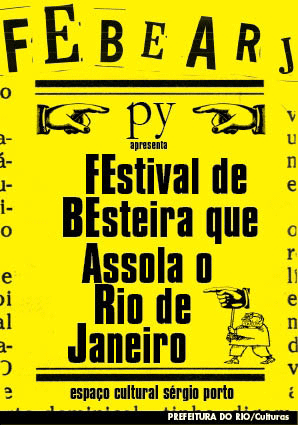
PyLar
πLAR The Homey Resistance
What is the relation between a slogan of the Movement of Landless Rural Workers (MST - Movimento dos Trabalhadores sem Terra) and an exhibition of visual arts whose main characteristic is taking place inside a home, and which takes as a starting point for artistic thinking this particularity?
The apropriation of the motto "occupy, resist, produce" firstly gives the PYLar exhibition an unequivocal political dimension. In the face of the ever-present risk of the degradation of art to the mere vehicle of ideologies, it is useful to recall Aristotle's celebrated phrase: "Man is by nature a political animal." Here we speak of the human need for association in view of a common good. Let us not therefore condescend to the debasement of politics.
The apparent contradiction between the public character of a broad political movement and the intimate, private sphere of the home, whose effect in this case touches the ironic, is resolved with some ease, I believe, if we consider the idea of micropolitics formulated by Felix Guattari: the necessary cross-linking of the molar (in reference to the macro level) and molecular (micro) vectors for the constitution of autonomous forces in the field of subjective economy - the field of the production of ideas, of art, of desire.
The diagnosis goes far beyond the novelty: to be an artist in Brazil is to navigate channels bounded by institutional indigence - a historical rule that the exceptions only confirm - and by the designs of the art market, with its own logic. The third bank of this river, in order to proceed in the fluvial metaphor, is neither isolation nor impotence.
The old struggle for hearts and minds, not for the purpose of capturing them, but for the possibility of surprising them, throwing them in unusual directions, on the flip side of the countercurrent. This is the political character that primarily interests us in art.
Curiously, the term economy derives from the Greek roots oikos (house) and nomos (administration). Nothing more appropriate. The orthopedics of subjectivity begins at home.
Welcome, stranger!

Pyrata
PY = ZAT
Rodrigo Morais
A guerilla operation that frees up an area of space, time or imagination. This is one of the possible definitions for the Temporary Autonomous Zone. Is PY a ZAT? The question becomes more interesting with the PYrata exhibition, for "pirate utopias," outlaw communities established on remote islands, are among the historical examples of ZATs, or proto-ZATs.
Taking the art to non-conventional places, to temporarily activated spaces is proposed by the PY. In this case, the boat Rio-Niterói. In the PYrata "operation", the targets of the release are the physical space of the boat, the time of travel and the very subjectivity of each passenger - transformed by the irruption of a festival that moves them from the normality of the day.
It is easy to notice that the PY constitutes a side, the social structure more favorable to the appearance of the ZAT. Unlike the family, closed in consanguinity bonds, the pack has as characteristics horizontality and the opening by ties of affinity. In this regard, I would say that PY is anti-famiglia.
The opening is visible in the porosity that marks the collective, in the way in which, at each event, different artists are added. And also in the way the group deals with this coming and going of others, accepting difference as part of themselves, to the point that their identity is constantly changing. "Metamorphic" and "chameleonic" informs PY about itself. And the metamorphosis, he points out, is the ace in the hole of a ZAT.
Rhizomatic structures, acting as non-hierarchical accentuated multiplicity, packs are metamorphoses of the war machine. Thus, PY, in addition to a ZAT, can be perceived as a war machine. But what kind of war? Not the one made with rifles and grenades, but the ones we fight armed by thouhts, fought around values.
The aim of the war machine is the establishment of creative escape routes, the composition of spaces of freeflow. By exploring territories and constructing alternatives to the institutionalized circuit of the art system, with which it will not shut down communications, PY wages on its guerrilla war for a new reality.

Py action,
Culture is what changes the world. Large demonstrations such as Bossa Nova, the Nouvelle Vague or Arte Povera, are some examples. When they reach the general public, transforming the world, they come with a grandeur that impresses. But in this this particular circumstance, a small group of people with common political, aesthetic and cultural interests, eager to act and create a context for what they believe in. Often even without knowing exactly what they believe in, but aware of the potential of intuition, will and strength.
In early 2005, I was invited by two young artists who had worked in my studio for an unusual exhibition that they and others were organizing in a place far from my everyday Rio, in Itaipu, Niterói, ... oh well, so I went! We set out to a remote beach in Itacoatiara. After the beach we finally arrived at the end of the day, getting lost a little bit here and there. Worth it! Suddenly we were in a group of four houses that rhythmically occupied the same plot of land.
These newly built homes were still in transit state, clean, in the "bone", that is, without flooring, tiling, painting. Its walls were pure plaster on gray cement color. Amazing! And there was a show going on with ups and downs as in any collective but with an amazing average.
It seemed to be an unexpected museum going from one room to the other. It was an exhibition / event that lasted a day or two. Right there was born the Py group.
Other Py shows were succeeding, as π = X², πyneo, all in Niteroi.
Formed by young people of Rio and Niterói, Rio being the metropolis, it is clear that the natural destiny of Py would cross the bridge to take place in Rio. But how? Again the improbable, make an event inside a ferry boat.
During a Saturday the event / manifestation / Py took place. Displayed inside one of the Cantareira ferry boats. This was called πrata (Pyrate). One of the boats was taken by a flag and a legion of artists, myself included, works with performances, dance ... finally a plurality of artistic expressions, crossing several times Rio-Niterói-Rio, leaving the common public, transiting through Guanabara Bay, perplexed by the unexpected, as well as the slightly stunned artistic community with the unpredictability of the group, its event production capacity and artistic quality of the displayed material.
The Py manifests as an accumulation of other groups. Like myself, many artists outside the main stream, of different ages and cultural presence in the Rio, were also invited to attend this event. Definitely the activity of Py has been a major vibration in the arts in Rio de Janeiro. Its most striking quality is to believe that art can happen all over the place, as well as museums, institutions and galleries. I do not believe that this is a review of these classic places, but the demonstration of a will that overflows the conventional boundaries of artistic routine, showing that all stages of the artistic event, creation, production and delivery can happen at the same time under the same skin!
I do not know exactly what the next action of Py will be, but it will definitely surprise, and I want to be around it, either within or beside it.
To the living,
Ernesto Neto















